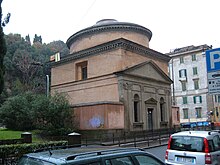| Sant'Andrea in Via Flaminia Saint Andrew in Via Flaminia (in English) | |
|---|---|
 Façade of Sant'Andrea del Vignola. Façade of Sant'Andrea del Vignola. | |
| Religion | |
| Affiliation | Roman Catholic |
| Location | |
| Location | Rome, Italy |
| Geographic coordinates | 41°55′16″N 12°28′19″E / 41.921191°N 12.472031°E / 41.921191; 12.472031 |
| Architecture | |
| Architect(s) | Giacomo Barozzi da Vignola |
| Type | Church |
| Style | Renaissance |
| Groundbreaking | 1550 |
| Completed | 1554 |
| Specifications | |
| Direction of façade | SW |
| Length | 13 metres (43 ft) |
| Width | 10 metres (33 ft) |
Sant'Andrea in Via Flaminia (English: Saint Andrew on Via Flaminia) is a Roman Catholic church dedicated to St Andrew the Apostle in Rome, Italy. The edifice is also known as Sant'Andrea del Vignola, after its architect Giacomo Barozzi da Vignola.
History
It was commissioned by Pope Julius III, in completion of a vow relative to his escape following the Sack of Rome, 1527. The small church on the Via Flaminia, scarcely more than a chapel, was designed by Giacomo Barozzi da Vignola in 1552 and completed the following year, while Vignola was also employed by Julius nearby at the Villa Giulia.
Sant'Andrea was the first church with an elliptical dome and the first step toward the Baroque world of elliptical forms.

The interior space is vividly expressed on the exterior. The tempio as it was long called, is an unadorned cube with a dentilled cornice without a frieze, surmounted by an elliptical low dome masked by a high plain drum with a comparable frieze, all in the gray pietra serena more usual to Tuscany than Rome. Applied to the street front is an extremely flat pedimented temple front, whose unadorned frieze is continued alone round the sides of the building, dividing the cube in the proportions 2:3. Very flat Corinthian pilasters, doubled at the corners, divide the applied facade in three bays, with shell-headed niches flanking the door. The façade is divided into pilaster strips with a central portal open between two grated windows.
Interior
Inside there are frescoes by Girolamo Siciolante da Sermoneta and Pellegrino Tibaldi.
Julius had the church engraved, plan, elevation and in perspective (G. Vasi 1761). After being long neglected, the unadorned geometry of the structure began to have an appeal to the popular Neoclassical style. The church was refurbished by the neoclassic architect Giuseppe Valadier, during the Napoleonic occupation of Rome, 1805.
See also
Notes
- Cuevas Del Barrio 2007, p. 109
- ^ "Chiesa di Sant'Andrea del Vignola (detto anche Tempietto di Sant'Andrea a Via Flaminia)", Turismo Roma, Major Events, Sport, Tourism and Fashion Department
References
- Watkin, David (2005). A History of Western Architecture. New York: Lawrence King Publications. p. 242. ISBN 978-1-85669-459-9.
- Cuevas Del Barrio, Javier (2007). "La evolución de las iglesias de planta ovalada. Hipótesis para la planta de San Carlo alle Quatro Fontane" (PDF). Boletín de Arte (in Spanish). 28. Departamento de Historia del Arte, Universidad de Málaga: 105–126. ISSN 0211-8483. Retrieved 2 December 2010.
Sant'Andrea in via Flaminia es la primera iglesia de planta oval que realiza Vignola. La construyó mientras trabajaba en la cercana villa Giulia y se terminó en 1554.
Further reading
- Huerta, Santiago (2007). "Oval Domes: History, Geometry and Mechanics". Nexus Network Journal. 9 (2): 211–248. doi:10.1007/s00004-007-0040-3.
- Bagliani, Stefano; Wetzk, Volker (May 2009). "The Architecture and Mechanics of Elliptical Dome" (PDF). Proceedings of the Third International Congress on Construction History. 85 (4). Cottbus: 302–303. doi:10.1002/bate.200890051. Retrieved 2 December 2010.
External links
- Official website of the Vicariate of Rome
- Roberto Piperno, "Ponte Milvio": following the Itinerary of G. Vasi, 1761.
- Sant'Andrea in Via Flaminia at archINFORM